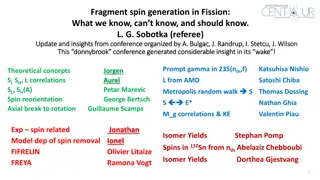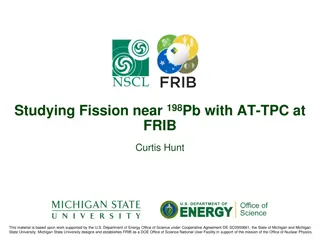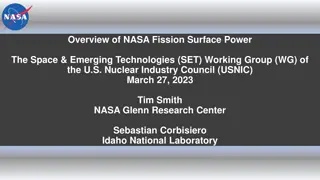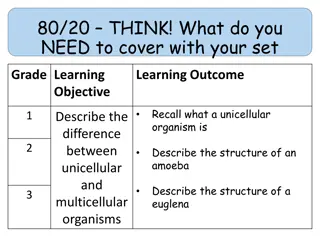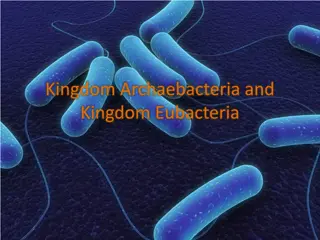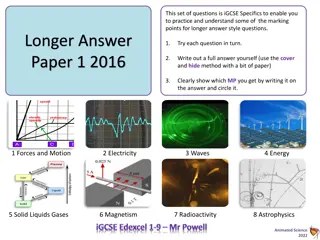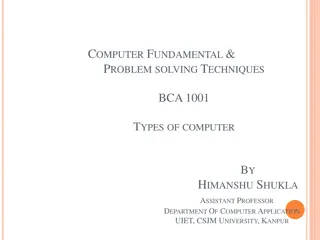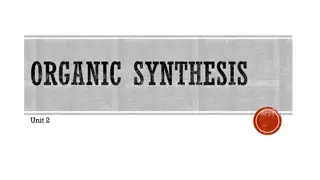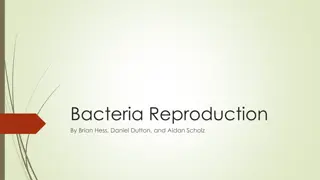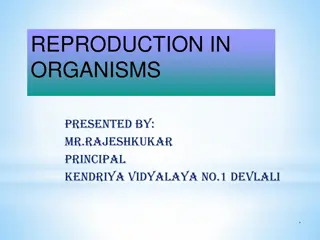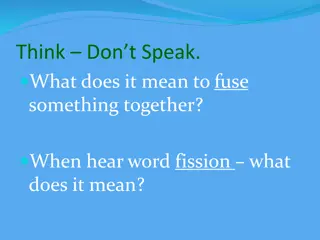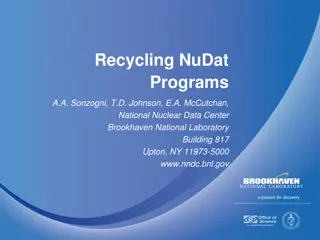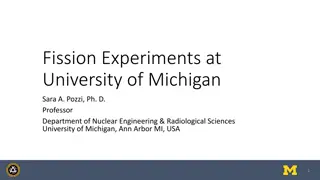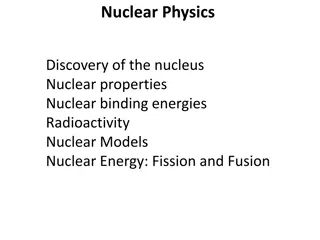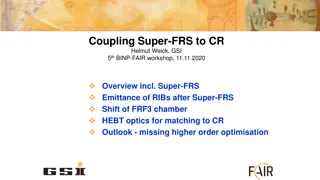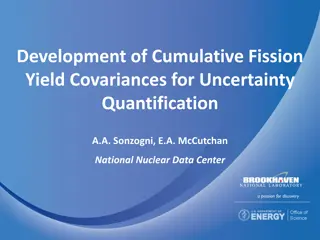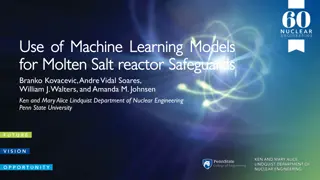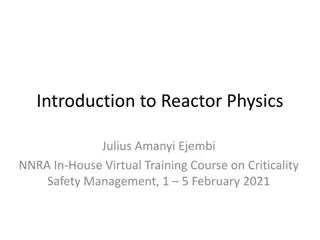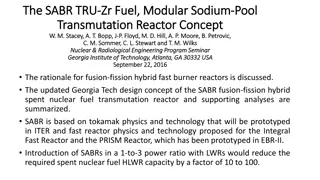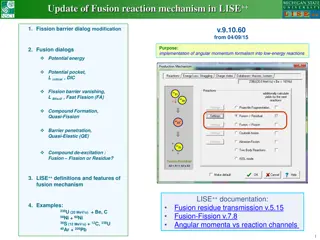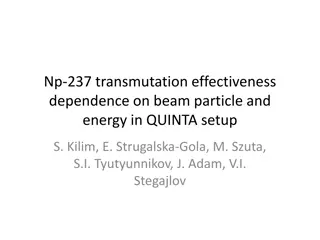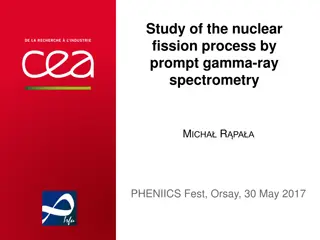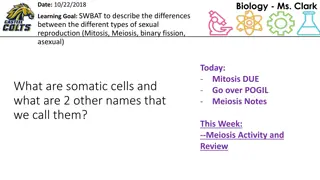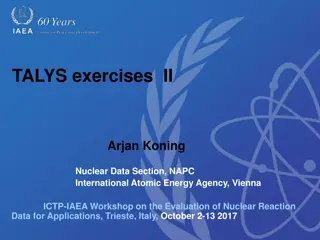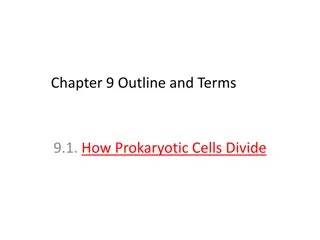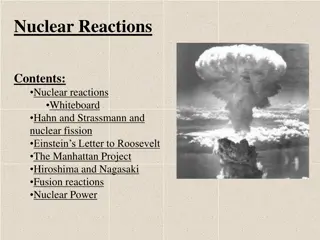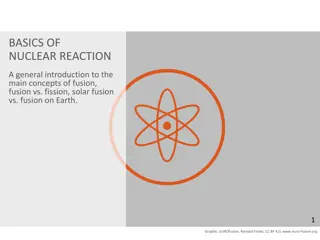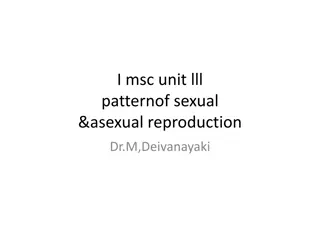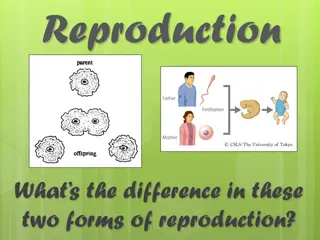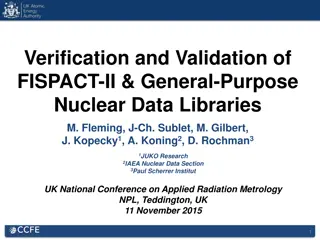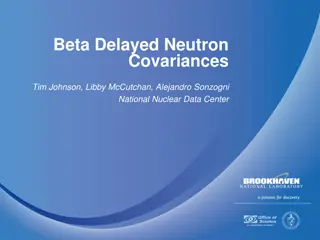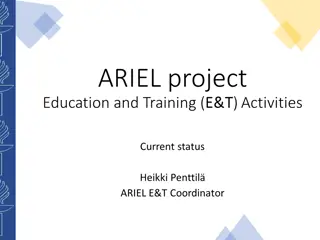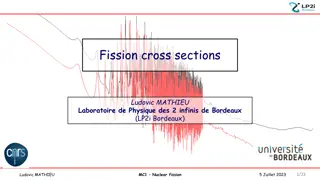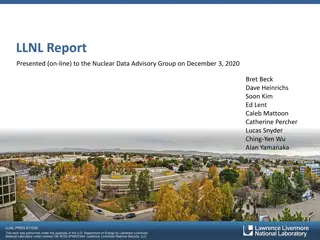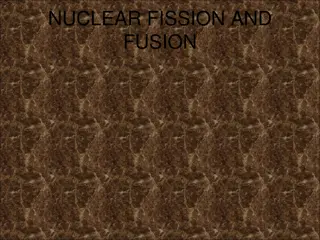Insights on Fragment Spin Generation in Fission: What We Know
Considerable insight was generated from a recent conference on fission, shedding light on crucial theoretical and experimental aspects. Key topics include angular momentum, fission-fragment spin references, and the dynamics of nuclear fission. Theoretical advancements like the TDSLDA model and super
3 views • 41 slides
Fission Near 198Pb with AT-TPC at FRIB: Insights from Curtis Hunt
Delve into the intriguing world of fission studies near 198Pb using the AT-TPC at FRIB. Supported by the DOE Office of Science, this research probes nuclear structure, fission properties, and fusion-fission reactions. By employing innovative techniques like the Heavy Isotope Tagger and active target
1 views • 39 slides
Italian Positioning and Perspectives in the Euratom-Fission Program
Exploring the Italian participation and achievements in the Euratom-Fission program, focusing on safety, advanced nuclear designs, tritium management, waste disposal, and radiation protection. Key themes include nuclear safety, waste management, radiation applications, and non-call actions. The Hori
1 views • 17 slides
NASA Fission Surface Power Overview: Enabling Sustainable Exploration of Moon and Mars
NASA's Fission Surface Power systems are pivotal for enabling sustainable energy production on the Moon and Mars, essential for human and scientific exploration missions. These nuclear power systems offer robust and continuous power in challenging environmental conditions, making them vital for supp
2 views • 11 slides
Exploring Unicellular Organisms: Amoeba and Euglena Structures and Characteristics
Journey into the microscopic world of unicellular organisms with a focus on Amoeba and Euglena. Discover the unique structures and behaviors of these tiny creatures, from Amoeba's adaptable pseudopod movements to Euglena's photosynthesis capabilities. Uncover how these organisms survive, feed, and r
0 views • 15 slides
Contrasting Kingdoms: Archaebacteria vs Eubacteria
Archaebacteria and Eubacteria are two distinct kingdoms of bacteria with unique characteristics. Archaebacteria, originating from Ancient Greek, are ancient organisms thriving in extreme conditions without peptidoglycan in their cell walls, while Eubacteria, the most common bacteria, have peptidogly
0 views • 11 slides
IGCSE Physics Practice Questions - Forces and Motion, Electricity, Waves, and More
Practice and understand marking points for longer answer questions in IGCSE Physics. Answer questions on topics like controlled nuclear fission, refraction, Hooke's Law, and electric motors to improve your knowledge and skills. Enhance your preparation with detailed explanations and marking points p
1 views • 8 slides
Types of Computers: Supercomputer, Mainframe, Mini, Workstation, Microcomputer
Computers come in various sizes and power ranges, each with unique capabilities. Supercomputers analyze nuclear fission models, mainframe computers have special circuits, mini computers support multi-user environments, workstations offer high processing speed, and microcomputers are affordable perso
0 views • 5 slides
Alkane Reactivity: Bond Fission and Halogenation
Alkanes, known for their low reactivity, can undergo halogenation in the presence of sunlight or UV light to form halogenoalkanes. This reaction is significant due to the non-polar nature of alkane bonds and highlights a rare reactivity pathway for these compounds. The process of bond fission, parti
0 views • 135 slides
Insights into Bacteria Reproduction and Cell Division
Explore the fascinating world of bacteria reproduction through binary fission, conjugation, and mitosis. Uncover the similarities and unique aspects of prokaryotic and eukaryotic cell division processes. Learn how conjugation plays a vital role in transferring genetic information between bacteria ce
0 views • 21 slides
Reproduction in Organisms: Overview and Types
Understanding the concept of reproduction in organisms, this content delves into the different modes of reproduction such as asexual and sexual, with examples and illustrations. It covers the life spans of various organisms and details various methods of asexual reproduction like fission, budding, s
0 views • 23 slides
Nuclear Fusion and Fission in Atoms
Nuclear fusion is the process where two atomic nuclei combine, releasing energy and forming a new element. This process occurs in stars where hydrogen fuses to create heavier elements. On the other hand, nuclear fission involves the splitting of an atomic nucleus, releasing energy. Understanding the
3 views • 35 slides
Nuclear Data Recycling Using NuDat Programs
Explore the use of NuDat classes in plotting beta-minus decay half-lives, electron capture processes, reliable ECp values, and antineutrino spectra calculations. Delve into topics like cross-section spectra, thermal fission yields, and the decay of various nuclides. The research also discusses assum
0 views • 14 slides
Advanced Fission Experiments at University of Michigan
The University of Michigan, under the guidance of Dr. Sara A. Pozzi, conducts cutting-edge fission experiments leveraging organic scintillation detectors. These detectors offer advantages such as nanosecond-scale response times, energy proportionality, and scalability. The experiments focus on impro
0 views • 4 slides
Unveiling the Fascinating World of Nuclear Physics
Delve into the discovery of the nucleus, nuclear properties, binding energies, radioactivity, and nuclear models. Explore nuclear energy through fission and fusion, uncovering the intricate structure of the atom and Coulomb's law. Witness Rutherford's groundbreaking experiments that revolutionized o
0 views • 14 slides
Overview of Electric Power Plants
Explore the functioning of various electric power plants including nuclear, fossil fuel thermal, hydroelectric, wind, solar, geothermal, biomass, and ocean power plants. Understand the processes involved in generating electricity from different energy sources such as fission, combustion, steam gener
0 views • 15 slides
Overview of Super-FRS Coupling to CR and Beam Envelopes
Overview of the Super-FRS coupling to CR including details on beam envelopes, acceptance after target Super-FRS, emittance of RIBs, and outlook for optimization. The content covers floor coordinates verification, beam envelopes at various points, ion reactions like fission and fragmentation on C-tar
1 views • 10 slides
Development of Cumulative Fission Yield Covariances for Uncertainty Quantification
This study by A.A. Sonzogni and E.A. McCutchan focuses on developing cumulative fission yield covariances for uncertainty quantification in nuclear reactors. The research involves calculating cumulative fission yields, using decay data and nuclear databases, to improve accuracy in predicting fission
0 views • 5 slides
Machine Learning for Molten Salt Reactor Safeguards
Molten salt reactors face challenges in material accounting due to liquid fuel which precludes traditional safeguards. This project proposes a two-step approach involving the development of measurement signatures created by material diversion, and a machine learning model to distinguish normal react
1 views • 18 slides
Introduction to Reactor Physics and Nuclear Fission
Explore the fundamentals of reactor physics, neutron interaction, and nuclear fission in this virtual training course on criticality safety management. Delve into the history of nuclear fission, symbolisms for atoms, and the significance of critical reactors like Fermi's Chicago Pile. Gain insights
0 views • 73 slides
Advanced Burner Reactor Concept and Subcritical SABR Design
Discusses the rationale behind fusion-fission hybrid fast burner reactors, focusing on the SABR concept for spent nuclear fuel transmutation. The SABR design aims to address challenges in nuclear power generation, waste disposal, and fuel efficiency by utilizing a subcritical advanced burner reactor
0 views • 15 slides
Interactive Guided Inquiry Technique in Chemistry Class
Explore how the Guided Inquiry technique is used in a Chemistry class to help students understand nuclear fission and fusion concepts through guided discussions and individual observations, ultimately reaching a class consensus on the topic.
0 views • 6 slides
Implementation of Angular Momentum Formalism in Low-Energy Fusion Reactions
This update focuses on integrating the angular momentum formalism into low-energy fusion reactions using the LISE++ platform. It explores fission barriers, potential energy pockets, compound formation, and de-excitation processes in fusion reactions. The documentation delves into fusion residue tran
0 views • 25 slides
Effectiveness of Np-237 Transmutation in QUINTA Setup
Np-237 transmutation effectiveness in the QUINTA setup depends on beam particle type and energy. The challenging nature of Np-237, with a long half-life and accumulation in nuclear waste, necessitates fission for disposal. Neutron capture results in the production of other actinides, making fission
0 views • 20 slides
Study of Nuclear Fission Process Through Gamma-Ray Spectrometry
Delve into the nuclear fission process through prompt gamma-ray spectrometry, exploring motivations, experimental data, and preliminary results. Understand the gamma heating process in nuclear reactors and its significance in reactor safety. Contextualize the study within Generation III+ and IV reac
0 views • 86 slides
Biology Class Learning Goals and Activities with Ms. Clark
Ms. Clark's biology class focuses on understanding the differences between types of sexual reproduction such as mitosis, meiosis, binary fission, and asexual reproduction. Students learn about somatic cells, genetic variation in meiosis, DNA, genes, and chromosomes. Activities include notes, videos,
0 views • 4 slides
Nuclear Reaction Data Workshop Highlights
Explore the TALYS exercises, sample cases, and project insights from the ICTP-IAEA Workshop on Nuclear Data Evaluation. Dive into subactinide fission, neutron interactions with different elements, and resonance parameter reconstruction with TALYS-1.8. Discover the intricacies of fission barriers, Ma
0 views • 13 slides
Cell Division Mechanisms in Prokaryotic and Eukaryotic Cells
Prokaryotic cells divide through binary fission, while eukaryotic cells undergo mitosis with nuclear division and cytokinesis. Prokaryotic cells lack a nucleus and divide by replicating DNA and forming two identical daughter cells. Eukaryotic chromosomes, associated with histone proteins, undergo co
0 views • 56 slides
Nuclear Reactions: Fission, Fusion, and Energy Release
This content covers various aspects of nuclear reactions, including nuclear fission, fusion reactions, the Manhattan Project, and examples of reactions involving different particles and elements. It explains concepts like exoergic and endoergic reactions, conservation of charge and nucleon number, a
0 views • 34 slides
Nuclear Reactions: Fusion, Fission, and Energy Production
Explore the fundamental concepts of nuclear reactions, including fusion and fission, the conversion of mass into energy, and the role of fusion in energy production. Discover how the sun and stars shine through fusion reactions and how we can replicate this process on Earth using isotopes of hydroge
0 views • 6 slides
Reproduction Methods: Asexual vs. Sexual Reproduction in Organisms
Asexual and sexual reproduction are two fundamental methods in nature, with asexual reproduction producing genetically identical offspring and sexual reproduction resulting in genetic variation. Asexual methods include fission, budding, fragmentation, and parthenogenesis, while sexual reproduction i
1 views • 6 slides
Asexual Reproduction and Passing of Traits
Asexual reproduction involves cell division to create genetically identical offspring. This process includes binary fission, budding, fragmentation, and vegetative growth. Offspring produced through asexual reproduction inherit traits directly from the parent organism. Understanding asexual reproduc
1 views • 24 slides
Verification and Validation of FISPACT-II & General-Purpose Nuclear Data Libraries
The paper discusses the verification and validation of FISPACT-II and general-purpose nuclear data libraries presented at the UK National Conference on Applied Radiation Metrology. It covers new features of FISPACT-II, fusion decay heat experiments, uncertainty quantification, collaboration opportun
0 views • 17 slides
Insights into Beta-Delayed Neutron Covariances by Tim Johnson, Libby McCutchan, and Alejandro Sonzogni
Comprehensive analysis and visualization of beta-delayed neutron covariances, fission yields, and their implications in nuclear physics applications. The research covers calculations of delayed nu-bar, neutron probabilities, and recommendations for various systems. Disagreements in fission yields fo
0 views • 26 slides
Cutting-Edge Research in Nuclear Physics
Cutting-edge research in nuclear physics is showcased in this comprehensive list of supported education and training applications. Covering a wide range of topics such as time-of-flight spectroscopy, nuclear reactions, data analysis, and neutron capture measurements, this document highlights the wor
1 views • 6 slides
Nuclear Fission Cross Sections
Nuclear fission cross sections play a crucial role in determining reaction rates in nuclear reactors and experiments. They represent the probability of nuclear interactions when neutrons collide with a nucleus, impacting fission and capture rates. These cross sections are influenced by factors such
0 views • 15 slides
Progress Update on Nuclear Data Research at LLNL
Nuclear Data Advisory Group received an online report from Lawrence Livermore National Laboratory detailing progress on various projects, including thermal neutron scattering laws processing, fission data measurements, and PPAC fission chamber development for 240Pu. The report outlines successful te
0 views • 19 slides
Nuclear Fission: Process, Examples, and Energy Generation
Nuclear fission involves the splitting of an atomic nucleus, with uranium-235 being a commonly used fissile material. When uranium-235 undergoes fission, it produces fission fragments, neutrons, gamma radiation, and kinetic energy. The fission process can be initiated by absorbing a slow-moving neut
0 views • 19 slides
Types of Cell Division: Binary Fission, Mitosis & Meiosis
Cell division comes in various forms - binary fission in prokaryotes, and mitosis and meiosis in eukaryotes. While prokaryotes divide through binary fission, eukaryotic cells undergo either mitosis for growth and repair or meiosis for sexual reproduction. Understanding these processes is crucial in
0 views • 50 slides
Fission Yield Studies in (n,f) Reactions at CNRS/LPSC Institute
Fission yield studies in (n,f) reactions are conducted at the CNRS/LPSC Institute to evaluate and test assumptions in fission yield models. The program focuses on isomeric ratios, isotopic distributions, and measuring kinetic energies using spectrometry techniques with the LOHENGRIN spectrometer.
0 views • 13 slides
